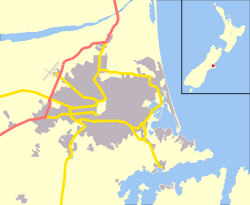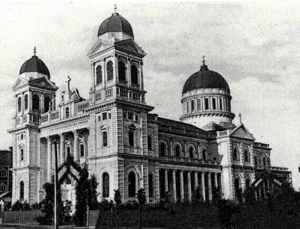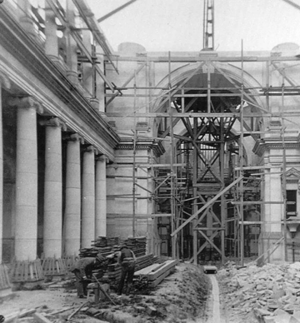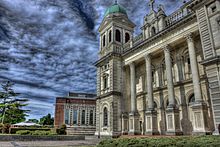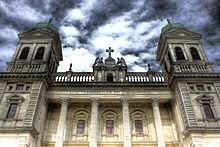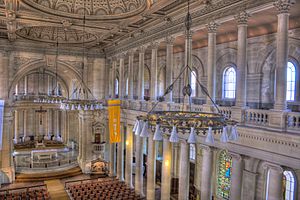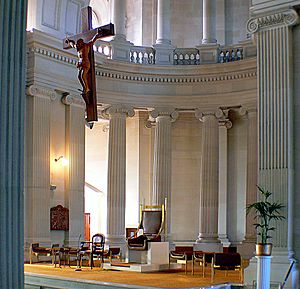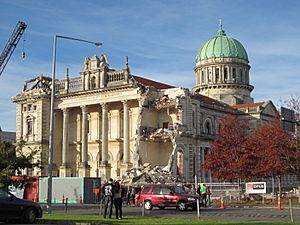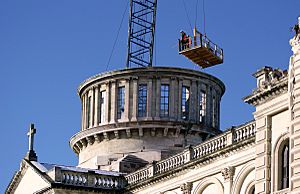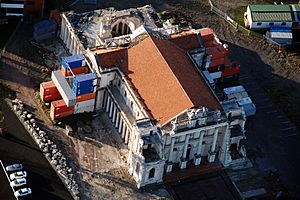Cathedral of the Blessed Sacrament, Christchurch facts for kids
Quick facts for kids Cathedral of the Blessed Sacrament, Christchurch |
|
|---|---|
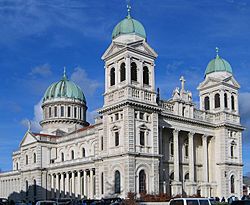
Cathedral as it appeared in 2005
|
|
| 43°32′18″S 172°38′46″E / 43.5383°S 172.6460°E | |
| Location | Christchurch Central City |
| Country | New Zealand |
| Denomination | Catholic |
| History | |
| Consecrated | 12 February 1905 |
| Architecture | |
| Functional status | Demolished |
| Heritage designation | Category I (7 April 1983) |
| Architect(s) | Francis Petre |
| Architectural type | Cathedral |
| Style | Renaissance Revival |
| Administration | |
| Diocese | Christchurch |
The Cathedral of the Blessed Sacrament was a large Catholic church in central Christchurch, New Zealand. People sometimes called it the Christchurch Basilica or the Catholic Cathedral. It was the main church for the Roman Catholic Diocese of Christchurch and where the Bishop of Christchurch had his official seat. Even though it was sometimes called a basilica, it wasn't officially one. This name was used because its design looked similar to some famous European basilicas.
The cathedral was designed by a talented architect named Francis Petre. Many people thought it was the best Renaissance-style building in New Zealand. On April 7, 1983, it was officially recognized as an important heritage building. It was seen as an amazing example of church architecture in Australia and New Zealand, and many believed it was Petre's best work.
The cathedral had to close after an earthquake on September 4, 2010. Then, a bigger earthquake on February 22, 2011, caused a lot more damage. The two bell towers at the front fell down, and the main dome became unstable. The dome was later removed, and the back part of the cathedral was taken down.
The decision to completely demolish the cathedral was announced on August 4, 2019. The demolition work finished in 2021. On December 7, 2019, the Catholic Bishop of Christchurch, Paul Martin, announced plans for a new cathedral. This new church, costing $85 million, was planned to be finished by 2025 and hold up to 1,000 people. It was to be built next to Victoria Square. However, these plans caused some disagreement among church members. In April 2024, Bishop Michael Gielen announced that a new cathedral would be built on the original Barbadoes Street site instead.
Contents
Building the Cathedral: A Look Back
In October 1860, a small wooden chapel was built on Barbadoes Street for new Marist priests. This chapel was replaced by a bigger wooden church in 1864, designed by Benjamin Mountfort. This building grew over the years. In 1887, it became the temporary main church for the new Diocese of Christchurch. This happened when Bishop John Grimes, the first Catholic bishop of Christchurch, arrived. This showed that the bishop planned to build a new, grander cathedral from the start. The old church was too small for the growing number of Catholics in the city.
In May 1897, Bishop Grimes traveled to Rome. He met Pope Leo XIII several times, and the Pope gave him two valuable gifts to help with the new cathedral project. Bishop Grimes spent 18 months traveling in Europe and North America. He preached and asked for donations for his cathedral wherever he could. He returned to Christchurch on January 10, 1899, with over £3,000 for the cathedral fund, including £800 collected in Ireland.
At that time, another large church, Wellington's Sacred Heart Basilica, was being built by Francis Petre. It's likely that Bishop Grimes asked Petre to design the Christchurch Cathedral in Wellington. Petre suggested a Roman basilica style. He later explained that this style was chosen because it was considered less risky in an earthquake and generally less expensive than the Gothic style. Bishop Grimes had the old church moved, and construction of the new cathedral began in 1901.
Huge efforts were made to raise money for the building. Bishop Grimes constantly toured his diocese to collect funds. Finding suitable stone for such a large building caused financial problems during construction. The then Premier, Richard Seddon, even helped pass a special law to assist with funding. The constant need for money and to build cheaply sometimes caused tension between the bishop and the architect. The Catholic community was smaller and less wealthy than the Anglican community, whose cathedral took 50 years to build. Yet, the Catholic community managed to complete their cathedral for £52,000 in just four years. Bishop Grimes said at the opening on February 12, 1905: "No one can claim that our stately Cathedral is the work of the wealthy. It is the fruit of the hard earnings of the poor and the lowly."
How the Cathedral Was Built
The cathedral was built by Jamieson and Sons, who constructed many other important buildings in New Zealand. Francis Petre had experience using concrete from his earlier work designing dock walls and sewers. This knowledge allowed him to use new methods during construction. For example, he poured concrete for the inner walls and then covered them with stone. Many parts were mass-produced, including curved arches made with a special machine. Fifty men worked on the site. They used over 120,000 cubic feet of stone, 4,000 cubic feet of concrete, and 90 tons of steel. After it was finished, the cathedral, made of concrete covered in Oamaru limestone, was highly praised. The famous writer George Bernard Shaw even compared Petre to the famous Italian architect Filippo Brunelleschi.
Cathedral Design and Style
Instead of the popular Gothic style of the 1800s, Petre designed the new church in a Renaissance, Italian basilica style. One big difference was the dome. Petre placed the green copper-roofed dome not over the middle of the church (like St. Peter's Basilica in Rome), but directly above the main altar area. Petre believed this design, along with the Byzantine apse (a curved end of the church), made the high altar look even grander. The roofs of the main hall (nave) and choir area (chancel) were held up by rows of Ionic columns. The front of the cathedral had two towers, similar to many large Renaissance churches in Europe.
Some people compared the cathedral's outside look to St Paul's Cathedral in London. However, it's thought that the biggest influence might have been the Cathedral of Notre Dame in Boulogne-sur-Mer, France. This French church has a very similar layout, including the dome placed over the altar. Petre was a student at a school in Boulogne-sur-Mer when this church was being rebuilt. The building was also said to be similar to the 19th-century Church of Saint-Vincent-de-Paul, Paris and Saint-Sulpice, Paris (17th century).
One expert said the outside of the cathedral was probably the most complete of all Petre's churches. The dome looked majestic from the back and stood out powerfully over the flat city of Christchurch, much like Brunelleschi's dome in Florence. George Bernard Shaw, during his 1934 visit, was very impressed with Petre's Catholic cathedral. In 1970, the cathedral was cleaned and restored.
The inside of the cathedral was also beautiful. Petre was very good at using natural light, making the main hall and altar area bright. The tall Corinthian and Ionic columns along the nave were a grand feature. The dome over the altar area was the most impressive part inside. It showed the full power of Petre's design and was considered his best work in 40 years. The way the arches supported the huge weight of the dome was fascinating. This sanctuary provided a fitting and dramatic setting for church services.
Earthquake Damage
The 2010 Canterbury earthquake on September 4, 2010, caused the cathedral to close to the public. It needed repairs and strengthening. Church services were held at other nearby places. However, Bishop Cunneen was buried in the cathedral after his funeral service at St Mary's Pro-Cathedral.
A stronger earthquake on February 22, 2011, caused much more damage. The cathedral's administrator, Charles Drennan, said engineers thought the building might not be saved. The two bell towers at the front collapsed, bringing down much of the front wall. Large pieces of stone crushed cars in front of the building. There were also big cracks around the main dome. Stained glass windows, which had survived the 2010 earthquake and many aftershocks, were also destroyed. Workers who were repairing damage from the earlier earthquake escaped safely, as did a caretaker inside the cathedral.
The building was described as "quite humbled." On the collapsed front, "all that was left at the top was a cross piercing the sky – two angels abreast keeping vigil." Bishop Drennan and three other priests had to leave the cathedral rectory (their living quarters) for safety reasons, even though their building wasn't damaged. Nearby parts of Catholic Cathedral College were threatened by the damaged cathedral, so the college had to move to St Thomas of Canterbury College.
What Happened Next
On March 2, 2011, Bishop Barry Jones decided the cathedral's dome had to be removed. An inspection showed that another large earthquake could make it fall completely. The bishop said the dome would be removed as soon as possible, but other work and equipment were needed first. Cranes would remove the dome from a safe distance because of the risk of collapse. The bishop also said no decisions about the building's future would be made until a detailed report was ready after the dome was gone.
On March 5, 2011, the Minister of Earthquake Recovery, Gerry Brownlee, said that he would like to see resources put into rebuilding the Anglican Cathedral, the Catholic Basilica, the Canterbury Provincial Chambers, and the Christchurch Arts Centre. He noted that these buildings would need a lot of strengthening and would not be rebuilt exactly as they were.
After the June 2011 Christchurch earthquake, the cathedral's dome was removed. The outer copper dome was cut into pieces and taken down on July 26. The inner decorative dome was removed in one piece in August. The damaged back part of the cathedral was demolished to a low level in October. Meanwhile, Catholic Cathedral College was able to move back into its buildings in August.
A Symbol of Hope
A statue of the Virgin Mary in the north tower of the cathedral turned 180 degrees during the February earthquake. Instead of facing inside, it faced out, looking over the damaged city. It became a symbol of survival. On May 29, 2011, the statue was carried around the damaged cathedral. About 200 people watched as the Bishop of Christchurch dedicated the city to Mary. The statue had been damaged during its removal but was repaired by Carmelite nuns in time for the procession.
Future Plans and Demolition
Fully restoring the cathedral was estimated to cost over $100 million, while building a new one would cost about $40 million.
By May 7, 2012, the Catholic diocese had spent about $3 million taking apart the damaged parts of the cathedral. They cleaned, saved, and numbered stones, windows, and other unique pieces. These were moved to a storage facility in west Christchurch. This careful storage allowed the numbered items to be kept in the best possible condition, in case they could be used in a rebuild or to guide new designs. The cathedral's future was considered alongside 20 other damaged churches in the Christchurch Catholic Diocese. The diocese also had to deal with insurance issues and decisions about other properties like schools and retirement villages.
In May 2015, it was announced that more of the front and altar areas would be taken down. The goal was to see if the main hall (nave), which seemed less damaged, could be kept and used in a new building. This plan, if it went ahead, would cost about $45 million and take four years. In October 2016, the investigation showed that the cathedral could be saved and rebuilt slowly, but it would cost $100 million. The final decision was left to the new Bishop of Christchurch, Paul Martin, who was appointed in 2018.
A New Cathedral
On August 4, 2019, Bishop Martin announced that the Cathedral of the Blessed Sacrament would be demolished. The cost to fully rebuild it was then $149 million. Even just saving the nave and rebuilding on a smaller scale was estimated to cost over $91 million. The bishop said these costs were too high for the diocese. He explained that they had spent millions studying the site and building, looking at over 20 different options. But in the end, they couldn't find a practical and affordable solution, so the 113-year-old earthquake-damaged church would be taken down. Demolition began on September 1, 2020, and finished in 2021.
On December 7, 2019, Bishop Martin announced plans for a new $85 million Catholic cathedral. It was planned to be finished by 2025 and hold up to 1,000 people. It would be built next to Victoria Square. This project would also include a hotel area, a moved St Mary's Primary School, a multi-story car park, a community hub, church offices, and homes for clergy. Funding would come from $45 million from the church's earthquake insurance claim for a cathedral. The bishop said the remaining money would be raised through donations and selling extra property, possibly including the old Barbadoes Street site. However, these plans caused some disagreement among church members. In April 2024, Bishop Michael Gielen announced that a new cathedral would be built on the original Barbadoes Street site instead.
Cathedral Music Program
| Cathedral of the Blessed Sacrament Music | |
|---|---|
| Choir and orchestra | |
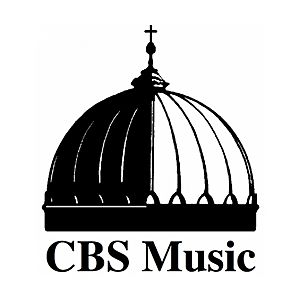 |
|
| Short name | CBS Music |
| Founded | 1969 |
| Location | Christchurch, New Zealand |
| Concert hall | Cathedral of the Blessed Sacrament (1969–2010), St Mary's Pro-Cathedral (2010–) |
| Principal conductor | Don Whelan |
The Cathedral of the Blessed Sacrament Music (CBS Music) group provides the main music for church services at St Mary's Pro-Cathedral today. Before the earthquakes, they were based at the Cathedral of the Blessed Sacrament. CBS Music is connected to the RSCM New Zealand Canterbury Branch.
The first choir was formed in 1969 by Don Whelan at Christ The King, Burnside. Whelan worked with Dutch immigrants who were good at singing in parts. He soon became a skilled organist, organizing singers and the choir. Before Easter 1969, an organist was needed for services at the Cathedral of the Blessed Sacrament. Whelan took this chance, and the CBS Choir was officially formed.
During their first international tour to Europe in 1990–1991, the CBS was recognized as cultural ambassadors by the New Zealand Government. On their third European tour, the choir was invited to lead the singing during the Papal Midnight Mass to celebrate the start of the Holy Year of Jubilee.
Because of the 2010 Canterbury earthquake, the Cathedral of the Blessed Sacrament was badly damaged and closed. Services moved to the nearby chapel. During the 2011 Christchurch earthquake, the cathedral partly collapsed, and the chapel and music center were also badly damaged and later demolished. The CBS built a new, modern facility at St Mary's Pro-Cathedral to hold their music library, offices, and a practice hall.
Despite the Canterbury earthquakes, the choir and orchestra continued their yearly New Zealand tours. They also went on their first Asian tour in 2012 and their fifth tours to Australia and Europe in 2013 and 2015. In October 2019, members of the CBS celebrated 50 years with Don Whelan as their leader.
In March 2020, the Catholic bishops of New Zealand temporarily stopped church services and closed churches because of the COVID-19 pandemic. The rest of the CBS program also stopped due to the national lockdown. Their "Wednesdays at One" music program, concerts, and appearances at Masses were paused for the first time ever. On June 14, 2020, the CBS was able to restart their program, celebrating the cathedral's feast of Corpus Christi. The "Wednesdays at One" music program started again in July 2020.
Concert Program
"Wednesdays at One" is a weekly concert series hosted by the CBS. It features local and national musicians of all ages performing works by many composers on different instruments. Annual concerts of Bach's St John Passion and Handel's Messiah are performed on Good Friday and in mid-December. In June, during the Diocese's Feast Day (Cathedral Feast of Corpus Christi) celebrations, a concert is given, often featuring a Mass. In 2019, John Ritchie's Missa Corpus Christi was performed, along with MacMillan's Hymn to the Blessed Sacrament and Mendelssohn's Verleih uns Frieden.
On the first Sunday of each month (except January), orchestral Masses are performed with the choir. Every other Sunday, the choir sings different types of church music, including traditional and Gregorian chant songs. Orchestral Masses with the choir are also performed at the Christmas Vigil and Midnight Mass.
Key People in Music
Here are some of the main people in the CBS Music program:
Director of Music:
- Don Whelan (1969–present)
Assistant Director of Music:
- Simon Mace (2018–2019)
- Nicholas Sutcliffe (2019–present)
Cantor:
- Wally Enright
Concertmaster:
- Natalia M. Lomeiko
People Buried Here
- John Grimes, the first Catholic Bishop of Christchurch.
- Edward Joyce, the fourth Catholic Bishop of Christchurch.
- John Jerome Cunneen, the eighth Catholic Bishop of Christchurch.
Related Information
- Christchurch Catholic Cathedral, the planned new cathedral
- St Mary's Pro-Cathedral, Christchurch, the temporary main church
- List of buildings by Francis Petre
See also
 In Spanish: Catedral del Santísimo Sacramento (Christchurch) para niños
In Spanish: Catedral del Santísimo Sacramento (Christchurch) para niños


